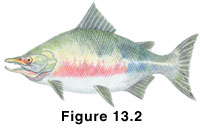 Description
DescriptionOncorhynchus keta (Chum
Salmon)
(Other common names: Dog Salmon, Fall Salmon, Calico Salmon)
Figure 13.2
 Description
DescriptionLength: 102 cm.
Mouth: large, terminal, directed forward; upper jaw reaches the posterior edge of orbit; snout is narrow; lips are fleshy; teeth in jaws well developed in sea-run salmon and in breeding males they are modified to canines; teeth also present in premaxillaries, maxillaries, palatines, and the anterior portion of the tongue.
Body: elongate; caudal peduncle moderately compressed; caudal fin slightly forked; adipose fin slender; 18-26 gill rakers over the first gill arch.
Color: metallic blue above (sometimes with dark speckles); silvery to white below; dark tips on anal, pectoral, and caudal fin; spawning males are gray-red with vertical green bars on their sides with dark gray beneath.
Depth: pelagic schooling; 0-250 m.
Habitat: open Pacific offshore waters and coastal streams.
Season: spawns in the winter to early spring (mainly winter); eggs hatch in the spring and move towards coastal nearshore waters and move offshore during the fall; spend two to seven years at sea then returns to rivers to spawn.
Diet: juveniles/young eat crustaceans (e.g., copepods, euphasiids), tunicates, molluscs (pteropods, squid) adults eat crustaceans (e.g., copepods, euphasiids), squid, forage fish species.
Predators: larger fish species including other salmon (on young), sea birds, marine mammals, and terrestrial mammals.
Distribution: North Pacific; southern California to Alaska to Bering Sea to the Arctic Ocean to Russia (Siberia) and the Sea of Japan.
 Scale
Description
Scale
DescriptionRelative Size of Scale: large.
Position of Scales on Body: 130-153 above the lateral line canal and 126-151 on the lateral line canal. (Hart, 1973).
Overall Scale Shape: circular to somewhat oval anterior field, the posterior field is often irregular.
Focus and Circuli: focus is clearly defined and often centralized between the fields; often just anterior to the interface of the posterior field. The circuli are concentric with the scale outline. The circuli are generally continuous between the lateral and anterior fields, but there is a small number of discontinuous circuli. The posterior field is clear, and some discontinuous circuli or reticulation may be present.
Radii: absent.
Remarks: Mosher (1969) reported that no freshwater nucleus present; heavy granular reticulation (globular reticulation) at the anterior/posterior interface; less than seven complete circuli below the focus but no circuli in the posterior field; radial striations and sculpturing in the posterior field. The Bilton et al. (1964) key allows for one or more ocean annulus. If there is more than one ocean annulus, then broken circuli will be absent from posterior field, or there will be two or less complete circuli in the posterior field. If only one ocean annulus exists, then broken circuli will be absent from the posterior field, or there will be two or less complete circuli in posterior field. The diameter of the first ocean band is 2.11 mm or greater.